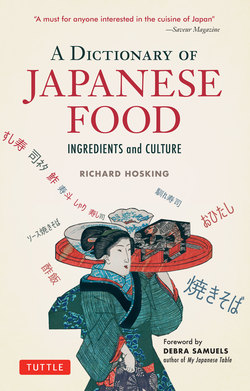Читать книгу A Dictionary of Japanese Food - Richard Hosking - Страница 8
На сайте Литреса книга снята с продажи.
ОглавлениеIntroduction
This is a dictionary of Japanese food, not a dictionary of food eaten in Japan. That is an important distinction that highlights the way the Japanese observe a strict distinction between Japanese style and Western or other style. Green tea is Japanese and is drunk out of Japanese-style handleless cups. Coffee is Western and is always drunk out of Western-style cups. Green tea appears in this book, coffee does not (except in passing). Curry rice, one of the most popular dishes in Japan, is not considered Japanese and therefore does not warrant an entry.
The approach of this book is that of a non-Japanese living in Japan, and the book is intended to be a help to other such people, as well as to any other speakers of English wishing to know about Japanese food. There is a great need for accurate information on this subject in English. In Japanese, a large number of excellent books is readily available, so the Japanese and those who can read Japanese are already well catered for.
There are some excellent books in English that give the background and context of Japanese food and eating. Donald Richie’s A Taste of Japan is first-rate. My favorite book on Japanese food is Mitsukuni Yoshida’s Naorai: Communion of the Table. Details of these and other useful books in English can be found in the list of Recommended Reading on pages 221. There is also a list of the Japanese books that have been valuable sources of reference on page 223.
Pronunciation of Japanese
All of the Japanese words that appear in this dictionary have been transliterated in Roman letters, basically according to the Hepburn system, which is practical rather than scientific. The important point to remember is that Japanese is spoken evenly in equally stressed syllables, as in Hi-ro-shi-ma and To-yo-ta. The syllables usually consist of a consonant followed by a vowel. There is never a consonant at the end of a syllable. You will often see n at the end of a syllable, but this indicates nasalisation of the preceding vowel and n is not a consonant in this case. A macron above a vowel, i.e., -, indicates that the vowel is long and should be lengthened in speech. In certain positions, unvoiced consonants become voiced. The s of sushi becomes z in nigirizushi. Similarly, k can become g, t can become d, and h can become b. For more specific information on Japanese pronunciation, readers should consult pages 13 through 19 of Carolyn R. Krouse’s A Guide to Food Buying in Japan, a most useful book.
Japanese Writing
There are three different scripts used for writing Japanese, and these are mixed together as needed. Two of the scripts, hiragana and katakana, are syllabaries. In this dictionary I give all native Japanese words in hiragana, and words of foreign origin are written in katakana. The third script is the Chinese script, which in many ways is more definitive than the syllabic writing, so I have tried to give the Chinese characters wherever possible. Some of those given are extremely rare and unusual, and therefore in my view all the more worth presenting.
Arrangement of the Dictionary
The dictionary is arranged in three parts: Japanese-English, English-Japanese, and Appendices.
The Japanese-English section is the part of the dictionary where almost all the details are given. The heading of an entry is always a Japanese word given in transliteration and printed in boldface. Certain Japanese words, such as sushi, tofu, and tempura, have become accepted as English. But as a heading, tofu becomes tōfu and tempura becomes tenpura. I extend this to kombu, which as an entry heading is konbu. Following the Romanized forms are written Japanese forms for recognition and identification. The scientific names of animals and plants are also important for correct identification, and these too, checked in Japanese sources, are included. Many of these names are hard to find and perhaps because they are in Latin, seem to get misspelled very easily. Even important publications are full of mistakes in this respect.
Cross-references are indicated by a boldface entry. Thus, shiso in the body of an entry means that there is a separate entry devoted to shiso that can be consulted. Some entries include cross-references to the Appendices.
The English-Japanese section is primarily a selective index to the Japanese-English section, which is referred to by the use of boldface. However, also included are some commonly used food items not found in the Japanese-English section, for example, bread and loaf of bread. Words that are the same or very similar in both languages, words like banana, butter, cheese, chocolate, and tomato, are generally not included in the dictionary.
The Appendices provide information in a more discursive way on topics that the reader should find interesting. Appendix 9, Sansai, is an exception, since it is a list of mountain vegetables.
Scientific Names
Scientific classification has always involved differences of opinion, quite apart from agreed changes. So I have tried to follow the best Japanese sources, which, for example, prefer Prunus to Armeniaca as the name of a genus, and campestris to rapa as a species of Brassica.
My experience writing this book suggests that scientific names are the cause of more headaches than anything else in this world!
There is no way that a book of this size could encompass the whole breadth of something so rich, extensive, and imaginative as the Japanese cuisine. Those who criticize the Japanese for lack of imagination should try a top-class kaiseki meal. The imaginative artistry of the chefs is quite extraordinary. All this book attempts to do is to provide basic and, I hope, accurate information. The only real way to understand Japanese food is to eat it, preferably in Japan.
